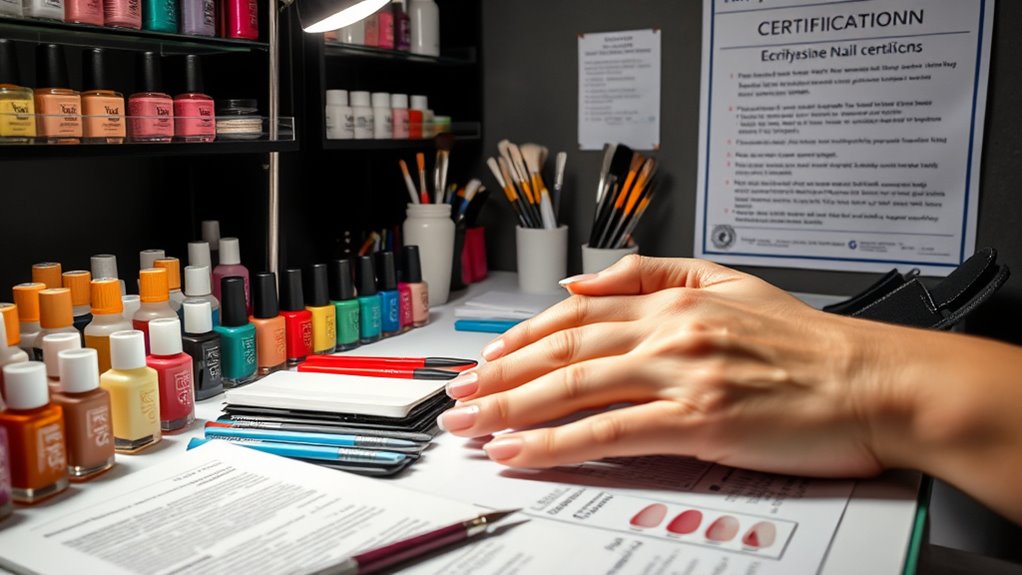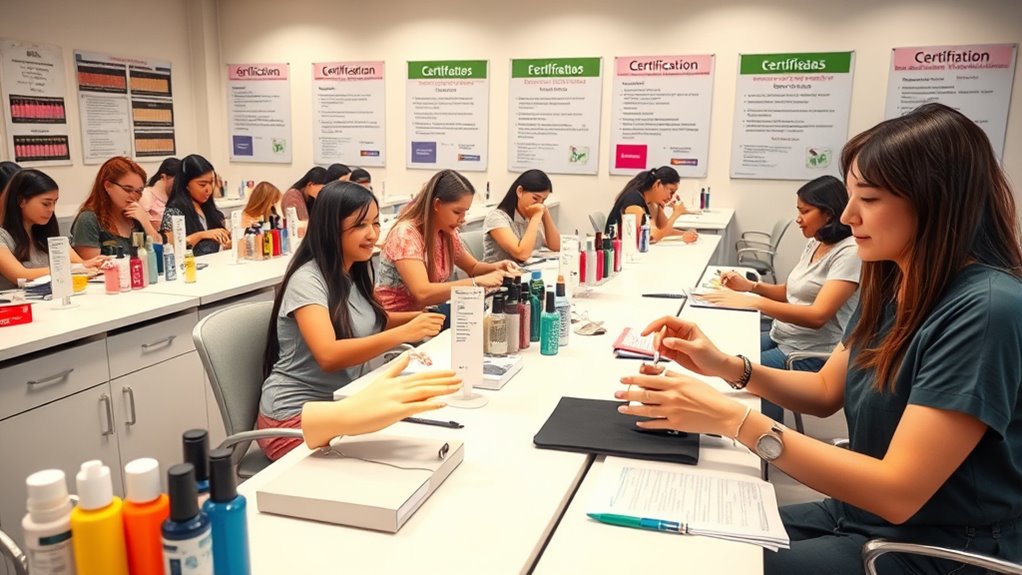To become a certified nail technician, start by understanding your state’s licensing rules and enroll in an accredited school that covers essential skills like nail art and sanitation. Complete the required training hours, pass the licensing exam, and pay associated fees. Keep your certification current with ongoing education and renewal deadlines. If you continue exploring, you’ll discover detailed steps and tips to help you succeed in your nail career.
Key Takeaways
- Complete state-mandated training hours, practical coursework, and pass a licensing exam covering safety, sanitation, and nail art techniques.
- Choose an accredited program offering hands-on experience and ensure it aligns with your career goals in nail artistry or salon management.
- Pay licensing and certification fees, submit application materials accurately, and maintain credentials through renewal and continuing education.
- Prepare thoroughly for the exam by practicing nail techniques, studying safety standards, and managing exam-related stress.
- Pursue ongoing education and advanced certifications to stay current, expand skills, and support long-term professional growth.
Understanding State Licensing Requirements

To become a licensed nail technician, you need to understand your state’s specific licensing requirements. These include familiarizing yourself with nail polish regulations, which dictate the types of products you can use and how they must be stored. You’ll also need to meet salon safety standards, ensuring your workspace is clean and sanitized to protect clients and maintain compliance. Each state has its own set of rules regarding hours of training, exams, and documentation, so it’s essential to research local regulations thoroughly. Staying current with licensing renewals and continuing education requirements is also vital for maintaining your credentials. Additionally, understanding water safety standards can be beneficial, especially if your practice involves aquatic or water-based treatments. These standards help prevent contamination and ensure client safety during water-related procedures. By understanding these specific requirements, you’ll set a solid foundation for a successful career as a certified nail technician.
Educational Programs and Course Options

When choosing an educational program, you’ll find various course types designed to fit your needs. It’s important to take into account whether the programs are accredited and if they offer recognized certification. Understanding these options helps ensure you get the proper training to succeed as a nail technician. Additionally, exploring programs that incorporate digital literacy can enhance your communication skills and adaptability in a modern salon environment. Incorporating diverse design options into your training can also prepare you to offer creative and personalized nail services to clients. For those seeking quality and affordability, considering programs with positive reviews highlighting their durability and performance can be beneficial in selecting the right training path. Being aware of product reviews and user feedback can further guide your choice towards reputable training providers.
Course Types Offered
Choosing the right course type is essential for becoming a certified nail technician, as educational programs vary in structure and intensity. You can opt for full-time, part-time, or online courses, depending on your schedule and learning style. Some programs focus heavily on nail art techniques, helping you create intricate designs and personalized styles, while others emphasize salon management skills, preparing you for business operations. Hands-on training is typically included, giving you practical experience in shaping, polishing, and applying enhancements. Consider whether you prefer an exhaustive program that covers everything or specialized courses in areas like nail art or salon management. Your choice will influence your skills, confidence, and career trajectory, so pick a course type that aligns with your goals and learning preferences. Additionally, understanding the costs involved can help you plan financially for your training. Being aware of accreditation and certification requirements ensures that your education meets industry standards and enhances your credibility as a professional. A thorough understanding of industry standards can also help you stay updated with current trends and best practices in the field. To make an informed decision, researching program reviews and student feedback can provide insights into the quality and effectiveness of various courses.
Accreditation and Certification
Selecting a reputable educational program begins with verifying its accreditation and certification standards. This ensures you receive quality training aligned with industry requirements. Look for programs accredited by recognized agencies that cover essential skills like Nail Art and Salon Management. Certification from these programs confirms your competence and boosts your credibility with clients and employers. Accredited courses often include hands-on practice, preparing you for real-world salon environments. They also stay current with industry trends, including advanced Nail Art techniques. Additionally, a certified program can help you meet state licensing requirements more easily. When choosing your course, research the provider’s credentials, reviews, and success rates. Ultimately, proper accreditation and certification set a strong foundation for your career as a professional nail technician. Incorporating sound recording techniques into your training can also enhance your understanding of equipment setup and environment management, giving you a competitive edge in the industry. Understanding industry standards and staying updated on evolving techniques can further elevate your professional profile, especially considering how creative practice fosters problem-solving and adaptability in your craft.
Enrolling in a Nail Technician School

Enrolling in a nail technician school is your first step toward turning your passion for nails into a professional career. During your training, you’ll learn essential skills like manicure techniques and proper use of nail care products. These programs typically cover everything from basic nail health to advanced design methods, giving you a solid foundation to build on. You’ll also gain hands-on experience under supervision, helping you develop confidence in your craft. Choosing the right school ensures you get quality instruction and access to up-to-date tools and products. Remember, this step is crucial for acquiring the skills needed to succeed as a licensed nail technician. Additionally, understanding the importance of proper sanitation and safety practices is vital for maintaining a reputable and hygienic salon environment. This knowledge is especially important because industry standards require strict adherence to sanitation protocols. Once enrolled, you’ll be well on your way to mastering the art of manicures and other nail services, and embracing professional development will help you stay current with industry trends and techniques. Gaining knowledge about nail product ingredients can also enhance your ability to recommend suitable products for clients and avoid potential allergic reactions.
Completing Required Training Hours

To become a certified nail technician, you need to complete a specific number of training hours. These mandatory hours vary by state and can include different requirements depending on your chosen program. Understanding your options helps guarantee you meet all the necessary criteria to earn your license. Additionally, many programs incorporate vetted training materials to ensure safety and quality standards are maintained throughout your education. Following a structured testing process can also help ensure all requirements are met efficiently. Familiarity with self watering plant pots can serve as a useful analogy for understanding consistent practice and maintenance during your training. Incorporating AI-enhanced learning tools into your coursework can further improve your skill development and knowledge retention.
Mandatory Training Hours
Completing the required training hours is a crucial step toward obtaining your nail technician certification. During your training, you’ll learn essential skills like manicure techniques that guarantee clients leave satisfied and safe. It’s also the perfect time to explore current nail art trends, helping you stay creative and competitive. The hours you spend practicing different techniques build your confidence and proficiency. Most states require a specific minimum of training hours, so make sure you meet or exceed this requirement. Focus on mastering foundational skills first, then expand into advanced designs. Staying disciplined and committed to completing your training hours sets a solid foundation for your future career. Once completed, you’ll be better prepared to pass the licensing exam and jumpstart your journey as a professional nail technician.
State-Specific Requirements
Each state sets its own specific requirements for completing training hours to become a licensed nail technician. Some states require as few as 200 hours, while others mandate over 400 hours. These hours typically include instruction on salon management and business marketing, preparing you to handle a professional environment and attract clients. You’ll need to verify your state’s exact requirements, as they dictate the number of hours and the curriculum content. Meeting these standards guarantees you gain essential skills for effective salon management and business marketing strategies. Failing to meet the hours or coursework could delay your licensing process. Be sure to track your hours carefully and stay informed about your state’s regulations to smoothly progress toward your certification.
Training Program Options
Are you wondering which training options will best help you achieve your required hours? You have several choices, including technical schools, community colleges, or specialized beauty academies. These programs often combine hands-on practice with classroom instruction, covering essential skills like nail art, sanitation, and salon management. Some courses focus more on creative techniques, like intricate nail art designs, while others emphasize business skills needed to run a successful salon. Make sure the program you select meets your state’s specific training hour requirements. Completing your hours through reputable programs guarantees you gain practical experience and confidence. Whether you prefer an intensive course or a part-time schedule, choose an option that aligns with your career goals and learning style.
Gaining Practical Experience

Gaining practical experience is a crucial step in becoming a skilled nail technician. It helps you develop your craft, build confidence, and understand salon dynamics. To do this effectively, focus on these key areas:
- Work in a Salon: Observe salon management and assist experienced technicians. Practice diverse nail techniques while learning how to handle scheduling and client flow.
- Customer Service Skills: Interact with clients to improve communication, manage expectations, and provide a positive experience that encourages repeat business.
- Seek Feedback: Request constructive criticism from mentors to refine your skills, manage time efficiently, and enhance your professionalism.
Hands-on experience sharpens your abilities, boosts your confidence, and prepares you for a successful career as a certified nail technician.
Preparing for the Certification Exam

To succeed on your certification exam, you need to focus on studying the exam content thoroughly and practicing your practical skills regularly. It’s also important to develop strategies to manage test anxiety so you stay calm and focused. By preparing effectively, you’ll boost your confidence and increase your chances of passing.
Study Exam Content
Wondering how to effectively prepare for your certification exam? Start by understanding the exam content thoroughly. Focus on key areas such as nail art techniques, sanitation protocols, and salon management principles. To help you organize your study plan, consider these essential topics:
- Nail Art and Design: Practice different styles and familiarize yourself with current trends.
- Safety and Sanitation: Master sterilization procedures, hygiene standards, and infection control.
- Salon Operations: Learn about client consultation, appointment scheduling, and business management.
Practice Practical Skills
Practicing your practical skills is essential to confidently pass your certification exam. Focus on perfecting core techniques like applying nail art creatively and accurately. Practice shaping nails, buffing, and polishing to ensure smooth, professional finishes. Remember, sanitation standards are critical—sanitize tools and workstations thoroughly to prevent contamination and demonstrate your professionalism. Repetition builds confidence, so dedicate time to simulate real exam scenarios, including performing manicures and pedicures under exam conditions. Keep your movements steady and precise, paying attention to detail in nail art designs. Reviewing sanitation protocols regularly helps you stay compliant and stress-free. The more familiar you are with practical procedures, the more naturally you’ll perform during the exam, increasing your chances of success.
Manage Test Anxiety
Managing test anxiety is essential for performing your best on the certification exam. When anxiety strikes, use mindfulness techniques like deep breathing to stay present and calm. Incorporate relaxation exercises such as progressive muscle relaxation to ease tension. Here are three strategies to help you manage stress:
- Practice mindfulness techniques daily to build resilience and focus.
- Use relaxation exercises, like deep breathing, before and during the exam.
- Develop a calming routine to reduce nerves, such as listening to soothing music or stretching.
Taking the Certification Test

Are you ready to tackle the certification test? This is your chance to showcase your skills in nail art and salon management. Before the exam, review key techniques, especially those you find challenging, to build confidence. During the test, stay calm and focused; remember to follow instructions carefully. You’ll likely be asked to demonstrate nail art design, so bring your best creativity and precision. Some tests may include scenario-based questions on managing a busy salon, so brush up on your customer service and organizational skills. Manage your time wisely, and don’t rush through sections. Trust your training and experience—you’re well-prepared to succeed and move closer to becoming a licensed professional.
Applying for Your State License

Ready to take the next step toward becoming a licensed nail technician? Applying for your state license is essential to work legally and showcase your skills in nail art and salon management. To get started:
- Gather your certification, proof of completed training, and exam scores.
- Fill out the license application form, ensuring all personal and professional details are accurate.
- Pay the required licensing fee and submit your application, either online or by mail.
Once approved, you’ll receive your license, allowing you to perform nail art professionally and manage salon responsibilities confidently. Keep track of renewal deadlines, and maintain your credentials to stay compliant with state regulations. Taking these steps ensures you’re fully licensed and ready to build your career.
Estimating Certification and Licensing Costs

Estimating the costs for certification and licensing is a crucial step in planning your journey to becoming a licensed nail technician. You’ll want to do a thorough cost comparison of exam fees, licensing applications, and required training programs in your state. These expenses vary widely depending on location, so understanding the total upfront costs helps you budget effectively. Keep in mind that certification validity differs by state—some require renewal every year, while others have longer periods. This affects your long-term costs, so include renewal fees in your estimate. By accurately calculating these expenses early, you avoid surprises later and ensure you’re financially prepared to meet all certification and licensing requirements smoothly.
Maintaining Your Certification and Continuing Education

Maintaining your certification and staying current with continuing education is essential to keep your license valid and your skills sharp. Regular licensing renewal guarantees you remain compliant with state requirements. To do this, you typically need to complete a set number of continuing education hours annually or biennially. Additionally, pursuing advanced certifications can enhance your skills and marketability.
Staying current with continuing education keeps your license valid and your skills sharp.
Here are three key steps:
- Keep track of licensing renewal deadlines and submit renewal applications on time.
- Complete required continuing education courses to fulfill licensing requirements.
- Seek advanced certifications to expand your expertise and stay competitive in the industry.
Consistently updating your credentials helps you maintain your license and grow professionally in the nail industry.
Frequently Asked Questions
How Long Does It Typically Take to Become a Licensed Nail Technician?
The training duration to become a licensed nail technician usually takes about 3 to 9 months, depending on your state’s requirements. The certification timeline varies based on how quickly you complete your coursework and practical hours. You’ll need to attend a state-approved program, pass written and practical exams, and submit your application. Staying focused on your training duration helps you achieve your certification timeline efficiently and start your career sooner.
Are Online Courses Accepted for Nail Technician Certification?
Online courses can be accepted for nail technician certification, but it depends on your state’s regulations. Many states require in-person training hours for certification validity, so check your local licensing board’s rules. Some online programs offer hybrid options, combining online learning with hands-on practice. Make sure the course is accredited and recognized by your state to guarantee your certification will be valid and accepted when you apply for your license.
What Are Common Challenges Faced During Certification Exams?
Imagine facing a towering wall of exam anxiety that clouds your focus. During certification exams, you often deal with technical skill gaps and nerves that threaten your confidence. These challenges can make it hard to perform your best. To conquer them, practice thoroughly, stay calm, and trust your training. Remember, overcoming these hurdles transforms your journey into a shining example of perseverance and skill mastery.
Can I Work as a Nail Technician in Different States With One License?
You can work as a nail technician in different states if your state licensing is acknowledged through reciprocity agreements. These agreements allow you to transfer your license without retaking exams, making it easier to practice across state lines. However, not all states have reciprocity, so you’ll need to check each state’s licensing requirements. Staying informed about reciprocity and state-specific rules ensures you can work seamlessly in multiple locations.
Are There Special Requirements for Military Veterans or Military Spouses?
You might worry about special requirements as a military veteran or spouse, but many states offer military veteran discounts and spouse licensing reciprocity. These benefits help you get licensed faster and with less hassle. Check your state’s specific rules, as some may waive certain fees or allow license recognition from other states. Take advantage of these programs to start your nail technician career smoothly and affordably.
Conclusion
Becoming a certified nail technician might seem challenging, but with the right planning, you can navigate each step confidently. From understanding licensing requirements to maintaining your credentials, every stage prepares you for a successful career. Are you ready to turn your passion for nails into a profession? With dedication and the right knowledge, you’ll be shaping beautiful nails and building a thriving business in no time. Your journey starts now—are you ready to take the first step?









